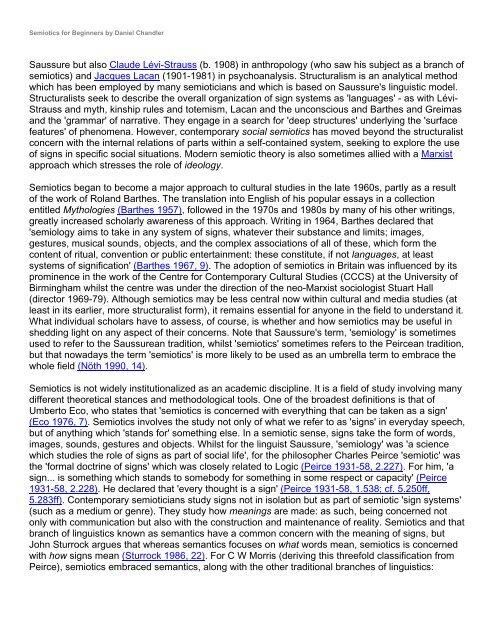Semiotics for Beginners by Daniel Chandler
Semiotics for Beginners by Daniel Chandler
Semiotics for Beginners by Daniel Chandler
Create successful ePaper yourself
Turn your PDF publications into a flip-book with our unique Google optimized e-Paper software.
<strong>Semiotics</strong> <strong>for</strong> <strong>Beginners</strong> <strong>by</strong> <strong>Daniel</strong> <strong>Chandler</strong><br />
Saussure but also Claude Lévi-Strauss (b. 1908) in anthropology (who saw his subject as a branch of<br />
semiotics) and Jacques Lacan (1901-1981) in psychoanalysis. Structuralism is an analytical method<br />
which has been employed <strong>by</strong> many semioticians and which is based on Saussure's linguistic model.<br />
Structuralists seek to describe the overall organization of sign systems as 'languages' - as with Lévi-<br />
Strauss and myth, kinship rules and totemism, Lacan and the unconscious and Barthes and Greimas<br />
and the 'grammar' of narrative. They engage in a search <strong>for</strong> 'deep structures' underlying the 'surface<br />
features' of phenomena. However, contemporary social semiotics has moved beyond the structuralist<br />
concern with the internal relations of parts within a self-contained system, seeking to explore the use<br />
of signs in specific social situations. Modern semiotic theory is also sometimes allied with a Marxist<br />
approach which stresses the role of ideology.<br />
<strong>Semiotics</strong> began to become a major approach to cultural studies in the late 1960s, partly as a result<br />
of the work of Roland Barthes. The translation into English of his popular essays in a collection<br />
entitled Mythologies (Barthes 1957), followed in the 1970s and 1980s <strong>by</strong> many of his other writings,<br />
greatly increased scholarly awareness of this approach. Writing in 1964, Barthes declared that<br />
'semiology aims to take in any system of signs, whatever their substance and limits; images,<br />
gestures, musical sounds, objects, and the complex associations of all of these, which <strong>for</strong>m the<br />
content of ritual, convention or public entertainment: these constitute, if not languages, at least<br />
systems of signification' (Barthes 1967, 9). The adoption of semiotics in Britain was influenced <strong>by</strong> its<br />
prominence in the work of the Centre <strong>for</strong> Contemporary Cultural Studies (CCCS) at the University of<br />
Birmingham whilst the centre was under the direction of the neo-Marxist sociologist Stuart Hall<br />
(director 1969-79). Although semiotics may be less central now within cultural and media studies (at<br />
least in its earlier, more structuralist <strong>for</strong>m), it remains essential <strong>for</strong> anyone in the field to understand it.<br />
What individual scholars have to assess, of course, is whether and how semiotics may be useful in<br />
shedding light on any aspect of their concerns. Note that Saussure's term, 'semiology' is sometimes<br />
used to refer to the Saussurean tradition, whilst 'semiotics' sometimes refers to the Peircean tradition,<br />
but that nowadays the term 'semiotics' is more likely to be used as an umbrella term to embrace the<br />
whole field (Nöth 1990, 14).<br />
<strong>Semiotics</strong> is not widely institutionalized as an academic discipline. It is a field of study involving many<br />
different theoretical stances and methodological tools. One of the broadest definitions is that of<br />
Umberto Eco, who states that 'semiotics is concerned with everything that can be taken as a sign'<br />
(Eco 1976, 7). <strong>Semiotics</strong> involves the study not only of what we refer to as 'signs' in everyday speech,<br />
but of anything which 'stands <strong>for</strong>' something else. In a semiotic sense, signs take the <strong>for</strong>m of words,<br />
images, sounds, gestures and objects. Whilst <strong>for</strong> the linguist Saussure, 'semiology' was 'a science<br />
which studies the role of signs as part of social life', <strong>for</strong> the philosopher Charles Peirce 'semiotic' was<br />
the '<strong>for</strong>mal doctrine of signs' which was closely related to Logic (Peirce 1931-58, 2.227). For him, 'a<br />
sign... is something which stands to somebody <strong>for</strong> something in some respect or capacity' (Peirce<br />
1931-58, 2.228). He declared that 'every thought is a sign' (Peirce 1931-58, 1.538; cf. 5.250ff,<br />
5.283ff). Contemporary semioticians study signs not in isolation but as part of semiotic 'sign systems'<br />
(such as a medium or genre). They study how meanings are made: as such, being concerned not<br />
only with communication but also with the construction and maintenance of reality. <strong>Semiotics</strong> and that<br />
branch of linguistics known as semantics have a common concern with the meaning of signs, but<br />
John Sturrock argues that whereas semantics focuses on what words mean, semiotics is concerned<br />
with how signs mean (Sturrock 1986, 22). For C W Morris (deriving this threefold classification from<br />
Peirce), semiotics embraced semantics, along with the other traditional branches of linguistics:




